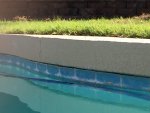Hi everyone, I know this has been asked a couple times before and I've seen a couple different answers...
I have pretty standard (for this area) slightly cantilevered concrete decking. Under the lip of the decking, between the deck and the top of the waterline tile, the grout is all deteriorated and most of it is missing, leaving a gap. When I bought the house the home inspector pointed it out and said it needs to be resealed. The pool got relatively little use last year and pretty mild use so far this year. It's just the missus and I having a relaxing float, no kids or parties with major splashing, etc.
As I mentioned in another thread I was planning to get the pool resurfaced this spring, with all new tile and deck refinishing. The tile/deck grouting would have been addressed as part of that, naturally.
Due to financial brutalities from other household expenses the resurfacing has been delayed. The missus is wanting to have a gathering on Jul 24th with about 10-15 people.
My hope was that I could DIY some kind of reasonable solution to seal up that gap to prevent any potential worsening of already bad situations with the pool, decking, etc.
I'm surprised that it seems like (I could be wrong) a traditional hard grout was used in there, my assumption is that's why it's all cracked and gone -- movement of the decking over time. I would have thought that something flexible should be in that gap.
My intent is to clean up any remaining major chunkage of grout and fill the gap with a caulking of some sort.
I've had a few folks suggest silicone, and seen it mentioned here, too. I've also seen mention of using polyurethane and not silicone.
This doesn't have to be a 10 year solution. I just need to solve the issue as best I can to protect from water getting in there and causing or worsening any problems for 6-12 months or so until I do get the resurfacing done.
Is 100% silicone caulking acceptable? Is there any reason not to? Why would I use polyurethane vs silicone?
I got some GE white silicone kitchen & bath caulk at Home Depot:
GE Silicone II 10.1 oz. White Kitchen and Bath caulk-HD5070 24C - The Home Depot
I can always return it if it's not the right solution here.
Thanks for the advice.
I have pretty standard (for this area) slightly cantilevered concrete decking. Under the lip of the decking, between the deck and the top of the waterline tile, the grout is all deteriorated and most of it is missing, leaving a gap. When I bought the house the home inspector pointed it out and said it needs to be resealed. The pool got relatively little use last year and pretty mild use so far this year. It's just the missus and I having a relaxing float, no kids or parties with major splashing, etc.
As I mentioned in another thread I was planning to get the pool resurfaced this spring, with all new tile and deck refinishing. The tile/deck grouting would have been addressed as part of that, naturally.
Due to financial brutalities from other household expenses the resurfacing has been delayed. The missus is wanting to have a gathering on Jul 24th with about 10-15 people.
My hope was that I could DIY some kind of reasonable solution to seal up that gap to prevent any potential worsening of already bad situations with the pool, decking, etc.
I'm surprised that it seems like (I could be wrong) a traditional hard grout was used in there, my assumption is that's why it's all cracked and gone -- movement of the decking over time. I would have thought that something flexible should be in that gap.
My intent is to clean up any remaining major chunkage of grout and fill the gap with a caulking of some sort.
I've had a few folks suggest silicone, and seen it mentioned here, too. I've also seen mention of using polyurethane and not silicone.
This doesn't have to be a 10 year solution. I just need to solve the issue as best I can to protect from water getting in there and causing or worsening any problems for 6-12 months or so until I do get the resurfacing done.
Is 100% silicone caulking acceptable? Is there any reason not to? Why would I use polyurethane vs silicone?
I got some GE white silicone kitchen & bath caulk at Home Depot:
GE Silicone II 10.1 oz. White Kitchen and Bath caulk-HD5070 24C - The Home Depot
I can always return it if it's not the right solution here.
Thanks for the advice.







